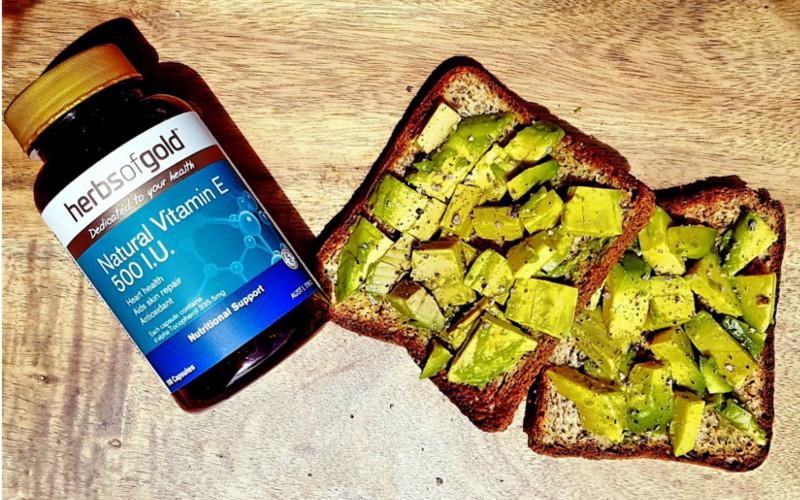Health Benefits of Vitamin E | Vitamin E Foods

Vitamin E - A Powerful Antioxidant
The health benefits of Vitamin E relate to its powerful antioxidant activity where it not only interacts with a host of other antioxidants, it can be recycled and regenerated back into its antioxidant form. Vitamin E can help with cardiovascular and immune health, arthritic pain, skin problems and period pain, amongst many others.
Vitamin E
Vitamin E is your most powerful fat-soluble vitamin which relies heavily on healthy fat digestion for absorption. The majority of vitamin E is stored in your fat cells with smaller amounts found in the heart, muscles, reproductive organs, and the adrenal and pituitary glands. D-alpha-Tocopherol is the most abundant and biologically active form of vitamin E with the highest bioavailability (dl-alpha-Tocopherol is a synthetic version of vitamin E).
Vitamin E Antioxidant Activity
Vitamin E is a key player in the body’s antioxidant network where it prevents free radical damage and oxidation from occurring, and once it has been used to neutralise free radicals, it can be recycled over and over again with the help of other antioxidants such as coenzyme Q10, vitamin C, glutathione and alpha Lipoic acid.
Vitamin E & Free Radicals and Oxidation
Free radicals are formed by a chemical reaction known as ‘oxidation’ – think of an apple slice that quickly turns brown – this is oxidation in action. During oxidation, important components of cells may become damaged and lose their ability to function normally.
Free radicals are unstable molecules that gain stability by stealing from other molecules. Antioxidants donate a molecule to the free radical for stability, so they don’t need to steal from other molecules.
Health Benefits of Vitamin E
- Supports cardiovascular health and may prevent hardening and narrowing of the arteries, may maintains healthy blood pressure, may inhibit platelet aggregation (‘sticky blood’) and provide anti-inflammatory activity.
- May help to slow down cognitive decline in older adults.
- May be of assistance in relieving premenstrual syndrome (PMS) symptoms and menstrual pain.
- Supports relief of menopausal symptoms.
- May relieve exercise induced leg pain and cramping.
- Provides antioxidant support in the management of arthritic pain.
- Supports fertility in men.
- Promotes wound healing for dry or cracked skin, burns, cuts, abrasions, skin legions, topically and orally.
- Prevents stretch marks and reduces scarring.
- Strengthens immunity and reduces the risk of bacterial infections.
Food Sources of Vitamin E
Good food sources of vitamin E can be found in animal and plant-based foods such as:
- Cold pressed vegetable oils - particularly wheatgerm oil,
- Nuts, seeds and avocados.
- Spinach, kale, sweet potato, yams,
- Egg yolk, liver, soya beans, asparagus and dairy products also contain some vitamin E.
Processing and cooking foods can easily destroy vitamin E, with up to 55% lost through cooking.
Do I need extra Vitamin E?
Your requirements for vitamin E are increased by exposure to pollution, pesticides, additives and radiation, and if you eat a highly processed or cooked diet. Some medications and fat malabsorption problems, seen in Crohn’s disease, chronic pancreatitis and liver disease, may reduce your absorption of vitamin E.
Therapeutic doses of vitamin E can typically range up to 2000 I.U./day (international units), with common supplemental doses between 100-500 i.u.
It’s very important to discuss your individual requirements with your healthcare practitioner, as vitamin supplements such as vitamin E may react with some medications. Vitamins may be of assistance if your dietary intake is inadequate.
References
Braun L & Cohen M (2010), Herbs & Natural Supplements: An evidence-based guide, 3rd Edition, Elsevier, Sydney.
Pizzorno JE & Murray MT (2013), Textbook of Natural Medicine, 4th Edition, Elsevier, Missouri.
Vitamin E viewed on 21/02/2018 at https://www.nhmrc.gov.au/_files_nhmrc/file/your_health/healthy/nutrition/17599_nhmrc_nrv_update-dietary_intakes_0.pdf
Zimmermann M (2001), Burgerstein’s Handbook of Nutrition; Micronutrients in the Prevention and Therapy of Disease, 9th Edition, Thieme, New York.







